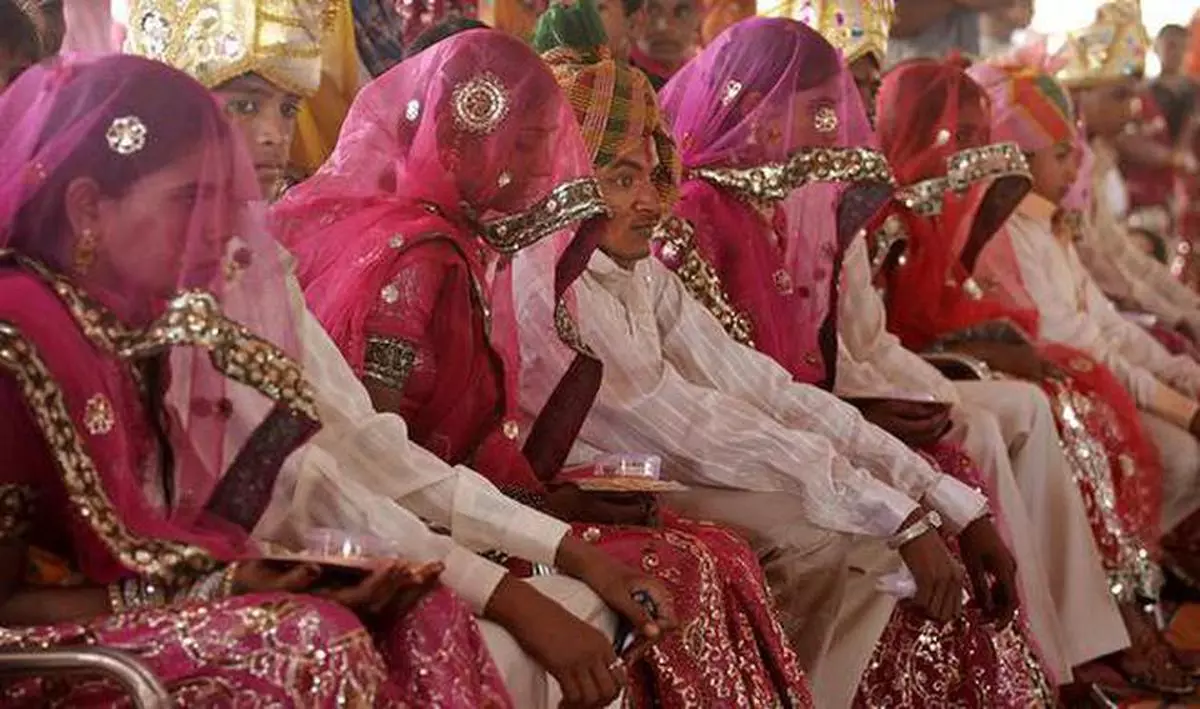- The Supreme Court has decided to investigate whether girls as young as 15 years old can marry under custom or personal law when such marriages are illegal under statutory law.
- The minimum age for marriage is 21 years for a man and 18 years for a woman under the Indian Christian Marriage Act of 1872, the Parsi Marriage and Divorce Act of 1936, the Special Marriage Act of 1954, and the Hindu Marriage Act of 1955.
- However, under Muslim personal law in India, which remains uncodified and unconsolidated, persons who have reached puberty, i.e. the age of 15 years, are eligible to marry.
- The Prohibition of Child Marriage (Amendment) Bill, 2021 attempted to amend the Prohibition of Child Marriage Act, 2006, by raising the minimum marriage age for women from 18 to 21 years.

What is Child Marriage?
- Any formal or informal union between a child under the age of 18 and an adult and another child is referred to as child marriage.
- The Prohibition of Child Marriage (Amendment) Bill, 2021, sets the marriageable age for women at 21 years.
Reasons for its prevalence
- The role of poverty: A large proportion of child marriages occur due to poverty and the burden of the high dowry costs associated with delayed marriages.
- Norms: Due to social norms in many regions and cultures, parents begin planning for a girl’s marriage once she reaches puberty.
- Crisis: Conflict exacerbates inequalities that put girls at risk of child marriage and its consequences. Families may arrange marriages for their daughters, believing that marriage will protect them from violence.
Issues with Child Marriage
(1) Social implications
- Child marriage has a greater impact on girls: Globally, the prevalence of child marriage among boys is one-sixth that of girls.
- Child marriage deprives girls of their childhood and endangers their lives and health.
- Exclusion: The practise can also isolate girls from their families and friends, as well as exclude them from participating in their communities, putting a strain on their physical and psychological well-being.
- Academic loss: Girls who marry before the age of 18 are more likely to experience domestic violence and are less likely to continue their education.
(2) Health issues
- Child brides frequently become pregnant during adolescence, when the risk of mortality for themselves and their infants is high.
- Girls are forced into adulthood before they are physically and mentally ready. This is the primary cause of global malnutrition prevalence.
(3) Economic impacts
- Child marriage has a negative impact on the Indian economy and has the potential to create an intergenerational cycle of poverty.
- It abruptly removes the children involved from the workforce before they reach adulthood.
- Girls and boys who marry as children are more likely to lack the skills, knowledge, and job opportunities required to lift their families out of poverty and contribute to the social and economic growth of their country.
- What is the global situation?
- According to UNICEF data, the total number of girls married as children is 12 million per year.
- It aims to put an end to the practise by 2030, the deadline set by the Sustainable Development Goals.
Where does India stand?
GOOD: A downward trend
- The overall prevalence of child marriage is decreasing, which is a positive trend.
- Child marriage in India fell from 47.4% in 2005-06 to 26.8% in 2015-16, a 21% point decrease over the decade.
- According to the most recent National Family Health Survey-5 data, it has decreased by 3.5% points in the last five years, reaching 23.3% in 2020-21.
BAD: The disparity between states is enormous.
- However, 3% is still a concerningly high percentage in a country with a population of 141.2 million people.
- Some states have a higher prevalence than the national average; for example, West Bengal, Bihar, and Tripura have more than 40% of women aged 20-24 married before the age of 18. (NFHS).
- Women in Kerala who married before the age of 18 fell to 6.3% in 2019-20, down from 7.6% in 2015-16.
Laws and policy interventions in India
There are crucial laws that aim at protecting children from violation of human and other rights including the-
- Prohibition of Child Marriage Act, 2006 and
- Protection of Children from Sexual Offences Act, 2012
- Raising the marriage age: A parliamentary standing committee is weighing the pros and cons of raising the marriage age for women to 21, as approved by the Union Cabinet.
- The Beti Bachao Beti Padhao Scheme seeks to address the issue of declining child sex ratios (CSR).
- Kanyashree scheme: According to women’s activists, West Bengal’s scheme provides financial aid to girls who want to pursue higher education. Bihar and other states have implemented a cycle scheme to ensure girls arrive at school safely, and UP has a scheme to encourage girls to return to school.
Way ahead
- Ensure education: Many of the benefits can be realised by ensuring that women complete at least 12 years of education.
- Upskilling: Bangladesh demonstrates that improving women’s education and providing them with modern skills that increase their employability reduces child marriage and improves health and nutrition.
- Criteria for educational attainment in schemes: Schemes that reduce the financial burden of marriage but require that the eligibility criteria be based on educational attainment as well as age demand consideration.
@the end
- A legalistic approach to raising the marriage age will only yield positive results if it leads to an increase in women’s education and skill acquisition for employability.
- A legalistic approach to ending child marriage may be counterproductive in the absence of improvements in women’s education or skills.
Source: https://prsindia.org/billtrack/the-prohibition-of-child-marriage-amendment-bill-2021
